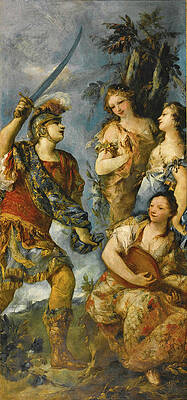Giovanni Antonio Guardi
Paintings
Rinaldo and the Nymphs
Danae
Carlo and Ubaldo Resisting the Enchantments of Armida's Nymphs


Herminia and Vaprino Find the Wounded Tancred

Herminia and Vaprino Find the Wounded Tancred, detail


Alexander the Great Before the Corpse of Darius III


Portrait of Marshal Matthias von der Schulenburg


Virgin and Child with Sts Dominic and Rosa of Lima

Virgin and Child with Sts Dominic and Rosa of Lima, detail

Holy Family with St John the Baptist and St Catherine




Madonna And Child With Saint John The Baptist


The sultan receives a delegation of dignitaries

The Sultan receives a sermon that brings him gifts


Scene in the garden of a serail


Dance of three Turkish couples in front of a fire
Jacopo Marcello Directing the Assault of Gallipoli

Fine Art Prints | Greeting Cards | Phone Cases | Lifestyle | Face Masks | Men's , Women' Apparel | Home Decor | jigsaw puzzles | Notebooks | Tapestries | ...
Giovanni Antonio Guardi (1699 – 23 January 1760), also known as Gianantonio Guardi, was an Italian painter. Guardi was one of the founders of the Venetian Academy in 1756.
Biography
Born at Vienna, he was the son of a minor Baroque painter from Trentino, and the elder brother of the more famous Francesco Guardi.
He may have received his artistic training in Vienna, where he is first recorded in 1719, but had established a workshop in Venice by 1730. Among his first important clients was the connoisseur and collector Johann Matthias von der Schulenburg, for whom Guardi multiple paintings with an Orientalist theme. He produced copies after the work of other artists, as well as a series of originals with Turkish-inspired interiors as easel pictures for private decoration. Antonio Guardi trained his younger brothers Nicolò and Francesco in his workshop, the latter working closely with him as a figure painter before establishing himself as a vedutista in the late 1750s.
A founder member of the Accademia Veneziana in 1756, the elder Guardi produced several works for churches in Venice, notably in the Church of the Angelo San Raffaele, as well as decorative cycles for palaces and villas in the city and the surrounding terraferma.
Francesco Casanova was among his pupils.
He died in Venice in 1760.
References
Bolton, Roy (2009). Old Master Paintings and Drawings. London: Sphinx Books. pp. 88–92. Retrieved March 2010.
Artist
A - B - C - D - E - F - G - H - I - J - K - L - M -
N - O - P - Q - R - S - T - U - V - W - X - Y - Z
Retrieved from "http://en.wikipedia.org/"
All text is available under the terms of the GNU Free Documentation License







